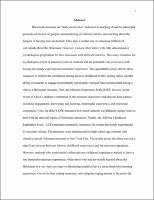Please use this identifier to cite or link to this item:
https://hdl.handle.net/20.500.12202/8906| Title: | Vicarious trauma experienced by visitors to a central Holocaust museum |
| Authors: | Pelcovitz, David Shawn, Karen Sokolow, Moshe Berenbaum, Michael Radensky, Paul Golding, Julie J. |
| Keywords: | Holocaust studies Museum studies Educational psychology Education Exhibits Holocaust Museums Seconary trauma Trauma-informed pedagogy |
| Issue Date: | 3-Mar-2023 |
| Publisher: | Yeshiva University |
| Citation: | Golding, J. J. (2023, March 3). Vicarious trauma experienced by visitors to a central Holocaust museum (Publication No. 30490144) [Doctoral dissertation, Yeshiva University]. |
| Series/Report no.: | Azrieli Doctoral Dissertations;PQDT Publication No. 30490144 |
| Abstract: | Holocaust museums are “dark tourist sites” dedicated to teaching about the attempted genocide of the Jewish people, memorializing six million victims, and warning about the dangers of leaving hate unchecked. They play a central role in educating millions of individuals about the Holocaust. However, visitors often arrive with little educational or psychological preparation for their encounter with difficult histories. This study examines the psychological effect of museum visits on students and the potential risks associated with having previously experienced a traumatic experience. This quantitative study utilizes three measures to explore the correlation among adverse childhood events, coping styles, and the ability of students to engage in potentially emotionally charged material presented during a visit to a Holocaust museum. First, the Museum Experience Scale (MES) focuses on the extent to which a student is immersed in the museum experience and assesses four aspects, including engagement, knowledge and learning, meaningful experience, and emotional connection. Next, the Brief COPE measures how much students use different coping styles to deal with the stressful nature of Holocaust education. Finally, the Adverse Childhood Experience Study (ACE) measures potentially traumatic life events previously experienced by museum visitors. The measures were administered to high school-age students who visited a central Holocaust museum in New York City. The results reveal that there was not a significant relation between adverse childhood experiences and the museum experience. However, students who experienced violent adverse childhood experiences tended to have a less immersive museum experience, while those who had previously learned about the Holocaust in a way that was scary or distressing tended to have a more immersive learning experience. Out of the four coping measures, only religious coping tended to be positively correlated with an immersive museum experience. Finally, there was some evidence that those who had previously met a Holocaust survivor were also more immersed in the museum experience. This study was conducted with the goal of improving the ability to provide proper psychological preparation and more psychological care during and after the program for students who visit Holocaust museums. |
| Description: | Doctoral dissertation, PhD / Open access |
| URI: | https://hdl.handle.net/20.500.12202/8906 https://ezproxy.yu.edu/login?url=https://www.proquest.com/dissertations-theses/vicarious-trauma-experienced-visitors-central/docview/2811494323/se-2?accountid=15178 |
| ISBN: | 9798379501853 |
| Appears in Collections: | Azrieli Graduate School of Jewish Education & Administration: Doctoral Dissertations |
Files in This Item:
| File | Description | Size | Format | |
|---|---|---|---|---|
| Julie Golding Dissertation OA May 2023.pdf | 404.82 kB | Adobe PDF |  View/Open |
This item is licensed under a Creative Commons License

